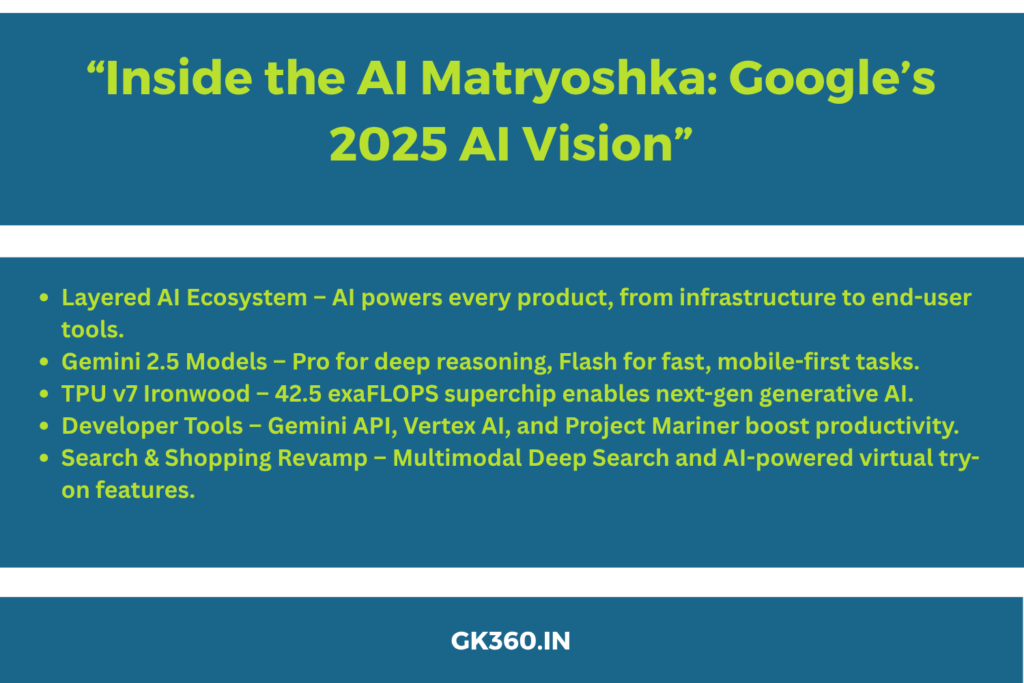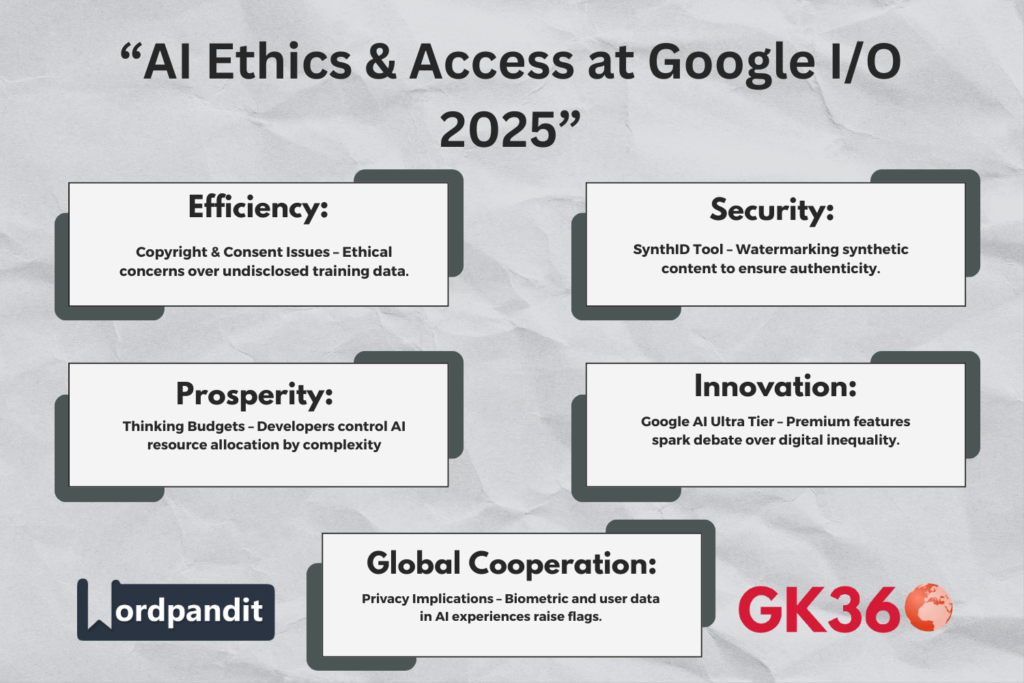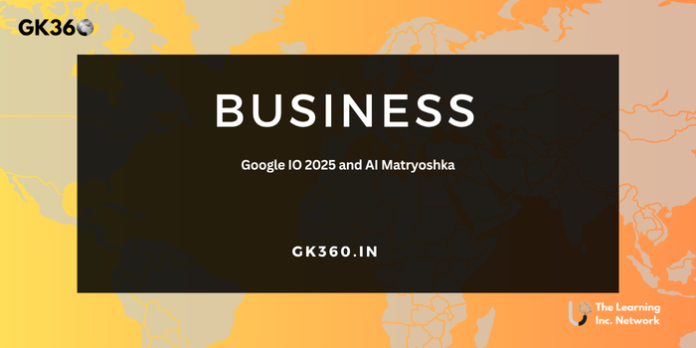Google I/O 2025 and the AI Matryoshka Strategy
Introduction
At the 2025 Google I/O Developer Conference, the tech giant unveiled a visionary new blueprint for its future—the “AI Matryoshka” strategy. This approach signifies a bold transition to an AI-first ecosystem, where every layer of Google’s infrastructure, applications, and user experiences is shaped by advanced artificial intelligence.
At the core of this transformation is the Gemini 2.5 series, a lineup of next-generation AI models designed to enhance reasoning, multimodal processing, and real-time content generation. From redefining Google Search to powering creative and productivity tools, these developments are not just technical upgrades—they’re a reimagination of how we engage with technology in everyday life.
However, this AI renaissance isn’t without concerns. As Google deepens its integration of AI, pressing questions about data privacy, copyright, and ethical governance come to the forefront, prompting a global conversation on responsible innovation.

Table of Contents
- Introduction
- Why Google I/O 2025 Matters: A Shift to an AI-First Future
- Gemini 2.5 Models Explained: Pro vs Flash & Use Cases
- Meet TPU v7 Ironwood: Google’s AI Superchip at I/O 2025
- Copyright, Consent & AI: Google’s Growing Ethical Challenges
- AI Tools for Developers: Gemini API, Vertex AI, & Project Mariner
- AI in Google Search, Shopping, and the Gemini App
- Google AI Ultra Tier: Access, Features & Privacy Implications
- FAQs: Your Questions Answered
- Conclusion: Google’s Bold AI Gamble & the Road Ahead
Why Google I/O 2025 Matters: A Shift to an AI-First Future
The 2025 edition of Google I/O was more than a developer conference—it was a strategic reset. At its core was the unveiling of an “AI Matryoshka” model, named after the nested Russian dolls, symbolizing AI’s layered integration into every Google product and platform.
This shift marks:
- A philosophical transition: AI is no longer a tool—it’s the foundation.
- A product-wide upgrade: From Google Workspace and Android to YouTube and Search, everything is being enhanced with contextual intelligence.
- A developer-first ecosystem: Tools like the Gemini API and Vertex AI make it easier than ever to build on this AI-first stack.
This AI-first strategy showcases Google’s ambition to outpace rivals like OpenAI and Microsoft by embedding AI into the user’s daily digital routines in more seamless, personalized, and automated ways.
Gemini 2.5 Models Explained: Pro vs Flash & Use Cases
Google’s newest models—Gemini 2.5 Pro and Gemini 2.5 Flash—represent two ends of the AI spectrum: power and performance vs speed and scalability.
🔸 Gemini 2.5 Pro
- Core Feature: “Deep Think” mode for complex reasoning tasks.
- Use Cases: High-end development tasks, advanced research, and enterprise-grade tools.
- Performance Benchmark: Outperformed peers in the USAMO 2025 math benchmark, indicating robust logic processing.
🔸 Gemini 2.5 Flash
- Core Feature: 20–30% more efficient token usage.
- Use Cases: Voice assistants, real-time translations, mobile interactions.
- Multilingual Reach: Offers multi-speaker text-to-speech in 24+ languages.
- Deployment: Will be the default model for the Gemini mobile app.
These models reflect Google’s attempt to cover both ends of the AI deployment pipeline—from lightweight consumer apps to enterprise-grade workloads.
Meet TPU v7 Ironwood: Google’s AI Superchip at I/O 2025
To support its increasingly complex AI models, Google introduced TPU v7 “Ironwood”—its most powerful custom hardware to date.
Key Features:
- Performance: 42.5 exaFLOPS per pod—10x faster than its predecessor.
- Optimized for: Image generation (Imagen 4), video synthesis (Veo 3), and music AI (Lyria 2).
- Impact: Sets the foundation for next-gen generative AI tools and real-time synthesis.
This launch is critical not just for scalability but for keeping Google competitive in infrastructure with companies like NVIDIA and Amazon Web Services (AWS).
Copyright, Consent & AI: Google’s Growing Ethical Challenges
Despite the excitement around Google’s technical achievements, concerns about data usage and copyright are intensifying. Critics argue that the Gemini 2.5 models were trained on massive, undisclosed datasets, raising ethical questions about:
- Creator consent: Was content used fairly?
- Transparency: What data sources were involved?
- Compensation: Are original creators being recognized?
In response, Google is championing SynthID and the SynthID Detector—AI watermarking tools that help detect synthetic content. While these tools aim to bolster content authenticity, they do not fully address the core issue of informed consent and transparent data use.
The debate reflects a broader industry-wide need for clear AI policies and standards for ethical training data usage.
AI Tools for Developers: Gemini API, Vertex AI, & Project Mariner
Developers remain central to Google’s AI vision. To empower them, several new tools were introduced:
🔹 Gemini API & Vertex AI Updates
- Model Context Protocol (MCP): Enables multi-agent collaboration, allowing different AI systems to coordinate on tasks.
- SDK integrations: Available across Python, JavaScript, and cloud platforms.
🔹 “Thinking Budgets”
- Developers can now allocate compute power based on task complexity.
- Helps balance cost and performance, especially for resource-intensive workflows.
🔹 Project Mariner
Automates repetitive processes in:
- Software development
- Data science
- Enterprise automation
Enhances productivity by suggesting workflow optimizations in real time.
Together, these tools make it easier for teams to build scalable, efficient AI-powered applications.
AI in Google Search, Shopping, and the Gemini App
🔍 AI Mode in Search
Google Search has been transformed into a contextual reasoning engine. Key feature:
Multimodal Deep Search, which can:
- Understand queries that include text and images.
- Deliver detailed, cited answers.
- Act more like a research assistant than a keyword-matching tool.
Agentic Checkout & Virtual Try-On
- Enables users to virtually try on products (e.g., glasses, clothes) before purchase.
- Supports biometric analysis to suggest better fit or alternatives.
- Raises new privacy questions about how user biometrics and financial data are processed and stored.
Gemini App Upgrades
- Live Mode: Real-time AI assistance across phone apps.
- Deep Research: The app can read user files and photos to deliver tailored summaries or creative outputs.
- Canvas Interface: Build infographics, generate audio recaps, or design visuals collaboratively with AI.
Google AI Ultra Tier: Access, Features & Privacy Implications
A major shift is the tiered access model—with the “Google AI Ultra Tier” offering premium features like:
- Access to the most advanced Gemini versions.
- Priority compute resources and faster processing.
- Enhanced content privacy settings.
But here’s the ethical dilemma:
Is this a “privacy premium”? Some argue that better data control and transparency shouldn’t require a subscription, raising concerns about digital inequality in the AI age.

FAQs: Your Questions Answered
- What is Google’s AI Matryoshka strategy?
It’s a layered approach where AI powers every part of Google’s ecosystem—from infrastructure to end-user products. - What’s the difference between Gemini 2.5 Pro and Flash?
Gemini 2.5 Pro is for high-performance tasks with deep reasoning. Flash is optimized for speed, efficiency, and mobile usage. - What is TPU v7 Ironwood used for?
It’s a next-gen chip used to train Google’s most advanced models, including those for video, music, and image generation. - How does Google address concerns about AI-generated content?
Through SynthID, a watermarking system that tags and identifies synthetic content. But concerns around consent and dataset sourcing remain. - What are “thinking budgets” in Vertex AI?
They allow developers to assign computing resources intelligently based on task complexity, helping optimize performance and cost.
Conclusion: Google’s Bold AI Gamble & the Road Ahead
Google I/O 2025 marked a paradigm shift in AI integration, showcasing how far generative technologies have evolved. The AI Matryoshka strategy, powered by Gemini 2.5 models, TPU v7 Ironwood, and new developer tools, lays the foundation for an era where AI is ubiquitous, personalized, and proactive.
Yet, as AI touches more aspects of life—from search and shopping to personal data and creativity—accountability, privacy, and equity must be just as integral to the design as innovation.
Key Takeaways Table
| Aspect | Details |
| AI Matryoshka Strategy | A layered AI-first design philosophy across all Google products. |
| Gemini 2.5 Models | Pro excels at deep reasoning; Flash is lightweight and efficient for mobile. |
| TPU v7 Ironwood | Google’s most powerful AI chip enabling 10x faster processing. |
| Developer Tools | Gemini API, Project Mariner, and Vertex AI upgrades enhance productivity. |
| Ethical Concerns | Copyright, consent, and transparency of training data questioned. |
| Search & Shopping AI | Multimodal Deep Search and biometric-based virtual try-ons launched. |
| Google AI Ultra Tier | Premium access to faster models and better data controls raises fairness issues. |





